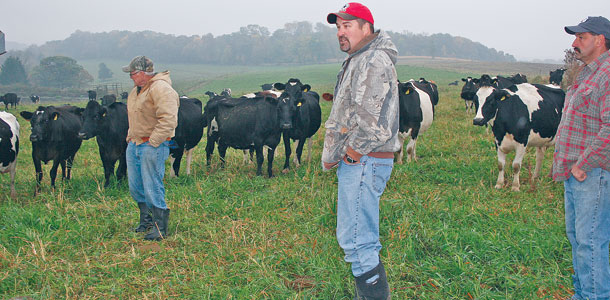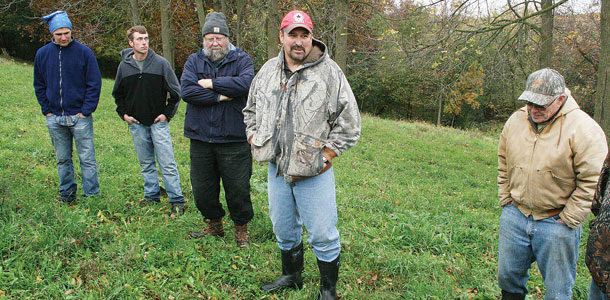“It’s all about profitability,” Wisconsin dairy farmer Don Boland says.
“You get paid for fat, protein and low somatic cell count.”
Boland’s farm, located in the hills of southwest Wisconsin near Gays Mills, has been in the family since the 1800s. Don formed a partnership with his dad, Mike, in the 1990s.
They built a milking parlor in 1999 and increased their cow numbers to 155. Mike retired in 2007, and Don now runs the farm with the help of his cousin, Sean Boland.
When he first returned to the farm to work with his dad, Don thought “milk production was everything.” The farm used a low-intensity grazing system, but within a few years, Boland realized a farm could do well without having high milk production as the only goal.
They started managing the pastures for high-intensity rotational grazing. “We still try to have the highest production we can, but we want to do it with what we already have here on our farm.”
Boland shared his management philosophies this fall at a pasture walk and facilitated discussion group hosted by the Great River Graziers. Boland is a believer in pasture walks.
“It’s a good way to learn from others and see new ideas. Then it’s up to you to sort through it and figure out what will work for you.”
Boland has operated the farm as a seasonal dairy for about 15 years, and he credits his use of New Zealand genetics for being able to breed all the cows at the same time. He says 90 percent of the herd calves in six weeks beginning March 15.
From the beginning of August until they dry up the cows at the end of January, they milk the cows about every 16 hours, milking three times over two days.
“Once they are past the halfway point in their lactation, production goes down, but they produce just as much fat and protein. It’s a good way to cut input costs – less labor, fewer towels, less cleaner, etc.,” he says.
He adds that it was hard to get past the idea of feeling “lazy” because he wasn’t milking twice a day.
Milk production last year was 11,130 pounds per cow with 4.96 fat and 3.68 protein levels. The average cow weight is 950 pounds.
He has 240 tillable acres, and about 120 of that is pasture, but Boland says pretty much any field is fair game for grazing until there is snow. The pasture acreage is divided into about 30 different grazing areas.

Boland is a big fan of Kura clover, which he says can really take the abuse of cattle and come back to yield well. He describes it as “similar to red clover but hardier,” and Kura can last up to 15 years
It spreads by rhizomes. It can sometimes be hard to get started but is persistent once it is established. “It may not be perfect in all ways, but my cows are used to it.”
He said the Kura in the calving pasture gets “pounded to pudding” in the early spring, but it comes right back.
His pastures also include reed canary, and he sometimes interseeds worn-out hay fields to switch them over to pasture.
Boland extends the grazing season as long as he can in the fall. “I’ll take the pastures down pretty low, but you need to keep rotating the animals – that is the key. The biological systems need to rest.”
In the winter, they pasture everything, and all the cows are outside all winter long. The terrain of the Boland farm offers hillsides and woods to help shelter them from the worst Midwestern winters.
All the corn he grows is made into silage. He feeds corn silage year-round, and his goal is to keep his flattest tillable ground in corn or alfalfa to prevent hillside erosion.
Boland rotates his pastures to sudangrass to get the pH levels back to recommended amounts, and the next year he plants reed canary and Kura clover.
At the home farm, he harvests three crops of alfalfa and stockpiles the fourth for the cows. He applies 40 units of nitrogen three times a year to his pastures, in early spring, early June and early August.
The cows receive alfalfa when freshening and 12 pounds of grain supplement straight through lactation. After the cows are bred, he cuts back on grain if the pastures are in good condition.
What they feed for grain varies with commodity prices; they are currently feeding wheat and soy hulls.
Boland completed a nutrient plan and now uses computer software uploaded with information from soil tests collected from four-acre parcels. “The information is extremely useful,” he says.
“It really opened my eyes to what the manure is worth, and I am more conscientious of where it belongs.”
He learned most of his tillable ground is high in phosphorous, and he now only winters the cows on places that need it.
Calves are kept at another farm Boland rents from his uncle. Once they are weaned, they have their own paddock system consisting of three acres they use on a rotational basis.
They return to the home farm to freshen. At this farm, he typically harvests two crops of alfalfa and stockpiles the third for the heifers.
Boland hunts whitetail deer, and he noticed in the early years of pasture management that if the forages were eaten down too short, the deer would leave. “I’ve actively worked to make it better for both the cows and the deer.”
Some wooded areas are only grazed three times a year, all before Sept. 1 with long rest periods. He says there is good re-growth to support the needs of the deer.
He was able to work with his heifers to restore a pasture from an overgrown wooded area. He cut down the scrub trees, such as box elder, one at a time so the heifers could eat the leaves.
They ate down the brush, and he let the heifers trample down reed canary seed. “It was unbelievable how well the seeding came in from just letting the cattle pound it in.” FG
Kelli Kaderly-Boylen is a freelance writer based in Iowa.
PHOTOS
TOP: Boland worked with his heifers to clear this overgrown wooded area, and even had the cattle work the reed canary seed into the ground.
BOTTOM: Don Boland of southwestern Wisconsin hosted a pasture walk on his farm this fall. Boland strives for low inputs to increase profitability. Photo by Kelli Kaderly-Boylen.











